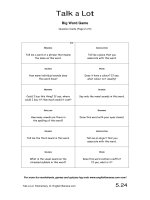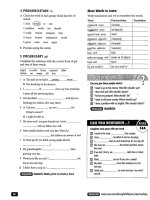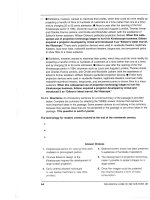reading skill 8 docx
Bạn đang xem bản rút gọn của tài liệu. Xem và tải ngay bản đầy đủ của tài liệu tại đây (60.4 KB, 6 trang )
Notice: Training to Begin for F.A.S.T.
Membership
A training calendar and schedule for Fire Agency
Specialties Team (F.A.S.T.) membership is avail-
able in this office to all applicants for F.A.S.T.
membership. Training will take place the third
week of each month. Classes will be taught on
Monday afternoons, Wednesday evenings, and
Saturday afternoons.
So that the F.A.S.T. can maintain a high level
of efficiency and preparedness for emergency
response situations, its members must meet cer-
tain requirements.
First, in order for you to be considered for
membership on F.A.S.T., your department must
be a member of the F.A.S.T. organization, and
you must have written permission from your fire
chief or your department’s highest ranking
administrator.
Once active, you must meet further require-
ments to maintain active status. These include
completion of technician-level training and cer-
tification in hazardous material (hazmat) opera-
tions. In addition, after becoming a member, you
must also attend a minimum of 50% of all drills
conducted by F.A.S.T. and go to at least one
F.A.S.T. conference. You may qualify for alterna-
tive credit for drills by proving previous experi-
ence in actual hazmat emergency response.
If you fail to meet minimum requirements,
you will be considered inactive, and the director
of your team will be notified. You will be placed
back on active status only after you complete
the training necessary to meet the minimum
requirements.
321. Potential F.A.S.T. members can attend less
than half of F.A.S.T. drills if they
a. complete technician-level training
requirements.
b. indicate prior real emergency experience.
c. receive permission from their fire chief.
d. enroll in three weekly training sessions.
322. Which of the following is the main subject of
the passage?
a. preparing for hazmat certification
b. the main goal of F.A.S.T.
c. completing F.A.S.T. membership
requirements
d. learning about your department’s F.A.S.T.
membership
323. Applicants must be available for training
a. three days each month.
b. three days each week.
c. every third month.
d. for 50% of classes.
– READING CHARTS AND GRAPHS, UNDERSTANDING DIRECTIONS–
75
One of the most common injuries teenagers and
adults experience is a sprained ankle. A sprain
occurs when the ligaments of a joint are twisted
and possibly torn. Ligaments are bands of stringy
fibers that hold the bones of a joint in position. A
sprain can occur from a sudden wrenching at the
joint, or a stretching or tearing of the fibers of the
ligaments. The injured area usually swells and
becomes black and blue. Stepping off the sidewalk
at the wrong angle or having one foot land in a
hole while jogging can leave you rolling on the
ground in agony with an ankle on fire! If you
cannot walk without experiencing intense pain,
you must seek medical help. If the pain is man-
ageable, and you can walk, here are three words to
help you remember how to treat yourself:
■
Elevate
■
Cool
■
Bandage
As soon as there is injury to that ligament,
there will be a certain amount of bleeding under
the skin. Once the blood pools around the dam-
aged blood vessels, inflammation and swelling
occur. The pressure from the swelling results in
additional stress and tenderness to the region. In
order to minimize the degree of swelling, lie down
as soon as possible and keep the ankle elevated so
that it is actually higher than your heart. Next, to
shrink the blood vessels and keep bleeding (hence
bruising) to a minimum, apply a cold pack. After
20 minutes, take the pack off, wait half an hour,
and then reapply. This can be done several times
a day for a total of three days.
Never leave a cold pack on for more than 20
minutes at a time. Reducing the temperature in
that area for an extended period of time signals
the body to increase blood flow to raise the body
temperature! Therefore, one inadvertently trig-
gers more blood distribution to the affected area
by leaving a cold pack on for too long! Finally,
bandage the ankle. Be careful not to wind it too
tightly; doing so can restrict blood flow and cause
harm to the entire foot.
324. The main idea of the passage is to
a. describe sprains to the ligaments.
b. explain how to bandage injuries.
c. explain how to treat your own sprained
ankle.
d. explain how the temperature of a wound is
important.
325. According to the passage, a sprain is caused by
a. enlarged blood vessels in the foot.
b. fluctuating temperature signaling the eleva-
tion of body temperature.
c. torn tissue in the ball of the foot.
d. torn or twisted ligament fibers that hold the
joint in position.
– READING CHARTS AND GRAPHS, UNDERSTANDING DIRECTIONS–
76
326. Which of the following is NOT mentioned as
a warning?
a. If there is intense pain, seek medical attention.
b. Do not wind the bandage too tightly.
c. Do not put your ankle near the fire.
d. Do not keep the cold pack on for more than
20 minutes at a time.
327. According to the directions, once the initial
cold pack is removed, what is to be done?
a. Begin wrapping the bandage.
b. Begin wrapping by encircling the ball of the
foot twice.
c. Wait 20 minutes and then reapply the ice
pack for 30 minutes.
d. Wait 30 minutes and then reapply the ice
pack for 20 minutes.
328. It can be inferred that the black-and-blue
symptom of the sprain is due to
a. torn fibers of ligaments.
b. too tight of a bandage.
c. bleeding under the skin.
d. dirt ground into the wound from the fall.
– READING CHARTS AND GRAPHS, UNDERSTANDING DIRECTIONS–
77
oetry scares some people, mainly because they believe that poems have hidden meanings. A good
way to approach poetry is by reading closely for the literal meaning. In reality, poetry compresses
the language into small sentences or phrases, so it just seems that the meanings are hidden. Ask
yourself, what is that poet’s view on the subject? If you add a few of your own thoughts and experiences, you
can uncover what has been left out. Think of it as frozen orange juice. Add water and you have the entire amount.
Also, remember that poets compare objects to other objects . . . just like the frozen orange-juice metaphor. Think
back to Section 2, Analogies, and remember the way you made comparisons there.
As you begin to read the poems in this section, it is important to understand who is speaking in the poem.
(The speaker may not be the poet.) Once you can identify the narrator, you should be able to get an idea of the
narrator’s attitude toward the subject, and this is easily discovered by the author’s word choice. Through the images
that the words make, you should be able to answer the questions correctly.
SECTION
Analyzing and
Interpreting
Poems
8
79
The answers to this section begin page 147.
The following poem is by Alfred, Lord Tennyson. Con-
sider the title of this poem as a guide to meaning.
The Eagle
He clasps the crag with crooked hands;
Close to the sun in lonely lands,
Ringed with the azur
e wo
rld he stands.
The wrinkled sea beneath him crawls;
He watches from his mountain walls,
And like a thunderbolt he falls.
329. Given the tone of the poem, and noting espe-
cially the last line, what is the eagle most likely
doing in the poem?
a. dying of old age
b. hunting prey
c. learning joyfully to fly
d. keeping watch over a nest of young eagles
330. To which of the following do the underlined
words azure world most likely refer?
a. a forest
b. the sky
c. the cliff
d. nature
331. In the second stanza, first line, to which of the
following does the verb crawls refer?
a. waves
b. sunlight on the water
c. the eagle’s prey
d. the eagle itself
This poem, by Emily Dickinson, is a sort of riddle.
Depending on your life experiences, the answer may be
immediately clear. Or it may very well not be. Look
closely for clues in the language.
A Narrow Fellow in the Grass
A narrow Fellow in the grass
Occasionally rides—
You may have met him—did you not
His notice sudden is—
The Grass divides as with a Comb—
A spotted shaft is seen—
And then it closes at your feet
And opens further on—
He likes a Boggy Acre—
A Floor too cool for Corn—
Yet when a Boy, and Barefoot—
I more than once at Noon
Have passed, I thought, a Whip-lash
Unbraiding in the Sun—
When, stooping to secure it,
It wrinkled, and was gone—
Several of Nature’s People
I know, and they know me—
I feel for them a transport
Of cordiality—
But never met this Fellow,
Attended, or alone—
Without a tighter breathing
And zero at the bone—
332. Who or what is the Fellow in this poem?
a. a whip-lash
b. a snake
c. a gust of wind
d. a boy
– ANALYZING AND INTERPRETING POEMS–
80









